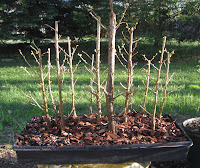 |
| Andy Smith discusses collected ponerosa pines. |
Andy Smith of Deadwood South Dakota recently presented a workshop with collected ponderosa pines for the Akron Canton Bonsai Society. During the day-long event, Andy offered a slide presentation that showed the incredible character of the species. The remarkable turns and undulations of these mountain trees tell stories of their struggles to survive in the tough rocky environment at high elevations in South Dakota.
 He also talked about methods he has developed over the years to coax the trees from their growing
places with minimal damage to the root systems. This often involves a crow bar and wedges, as well as a
shovel, but he has learned to greatly increase his survival rate.
He also talked about methods he has developed over the years to coax the trees from their growing
places with minimal damage to the root systems. This often involves a crow bar and wedges, as well as a
shovel, but he has learned to greatly increase his survival rate.  The trees offered to ACBS members were collected in areas where forestry management aims to thin the numbers of trees. He secures a permit to collect from the U.S. Forestry Service.
The trees offered to ACBS members were collected in areas where forestry management aims to thin the numbers of trees. He secures a permit to collect from the U.S. Forestry Service. Andy demonstrated how to plant the collected specimens into training pots. He explained that in most cases the trees are growing in small cracks in the rocks, and they are living in what little soil there is. Such growing conditions create a very dense root ball. He used a chop stick he created spaces between the packed roots in order to allow watering to be more uniform. For the transplant into training pots, he recommended a fairly gritty soil mix. He also believes that waiting out the coming summer season before attempting any styling on the trees would give the best chance for survival. Being patient will allow the tree to recover and get healthy over the course of this season. Then in subsequent years, begin working on any pruning, wiring and other styling considerations.

Many of the collected trees were estimated to be 40 to 60 years old. The incredibly textured bark, as well as the deadwood and movement seen in some of the trunks of the trees was testimony to both the age and the conditions under which the trees were growing. The combination of these qualities, along the flexibility of the branches should, in time, make them excellent bonsai.


As few ACBS members in the have experience working with ponderosa pines, it might be helpful to also study information from clubs in western states. A good summary of care and development of ponderosa pine for bonsai has been posted by the Phoenix Bonsai Club, which has a number of members who work with poderosas, at this link.
 Over the next several seasons, members are encouraged to bring their trees to club meetings, so that we can learn from each other and see how they are being styled and how develop.
Over the next several seasons, members are encouraged to bring their trees to club meetings, so that we can learn from each other and see how they are being styled and how develop. Much thanks to Andy for making the trek to Ohio, and also to our own Gib and Mat who planned and organized the event.









